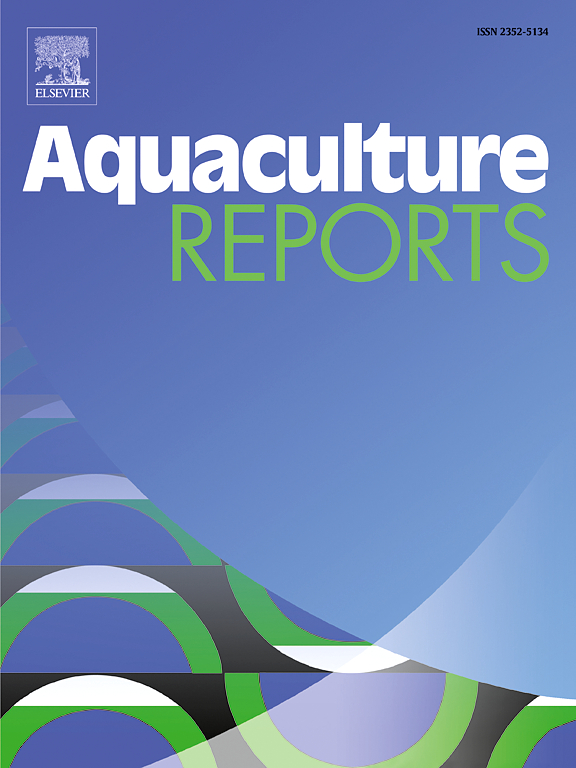Effect of replacing fishmeal with 70 cottonseed protein concentrate on growth performance, liver health, muscle texture, intestinal microbiome, and wastewater parameters in hybrid grouper (Epinephelus fuscoguttatus♀ × E. lanceolatus♂) juvenile
IF 3.2
2区 农林科学
Q1 FISHERIES
引用次数: 0
Abstract
As a superior protein historically applied in aquaculture, cottonseed protein has been processed by various deep processing methods to improve its utilization in aquafeeds. In this study, 70 cottonseed protein concentrate with low-gossypol (70 C) was used to replace fishmeal (20 %, 40 %, 60 %, and 80 %) to evaluate the effect on hybrid grouper (Epinephelus fuscoguttatus♀ × E. lanceolatus♂) juveniles (15.00 ± 0.05 g). After a 7-week feeding trial, 40 % 70 C replacing fishmeal had no negative impact on the growth performance of juveniles (P > 0.05). Serum biochemical indices, including alanine aminotransferase (ALT), albumin (ALB), and total cholesterol (TC), were significantly reduced with an increase in dietary 70 C (P < 0.05), suggesting that liver function was impaired, which was further confirmed by the alteration of hepatic morphology. Moreover, the core microbiota of the intestine were majorly Proteobacteria, Firmicutes, Cyanobacteria, Bacteroidota, and Actinobacteriota, etc. at the Phylum level. At the Genus level, Enterobacter significantly decreased with increasing dietary 70 C (P < 0.05). NS3a_marine_group, Sphingomonas Amaricoccus, Craurococcus_Caldovatus, and Agrococcus achieved the highest abundance, whereas Nocardioides and Lachnoclostridium had the lowest abundance in the 70 C20 group. Furthermore, the abundance of Photobacterium and Amaricoccus was more overrepresented in the 70 C60 group than in the other two groups (P < 0.05). The abundance of the predicted pathways related to butanoate metabolism increased in the 70 C group compared to the FM group. Thus, we hypothesized that dietary 70 C would influence the composition of the intestinal microbiota, thereby affecting flesh texture and degrading water quality. Our research provides a theoretical basis for widening the application of cotton protein concentrates in grouper aquafeeds.
70棉籽蛋白精替代鱼粉对杂交石斑鱼幼鱼生长性能、肝脏健康、肌肉质地、肠道微生物群和废水参数的影响
棉籽蛋白作为一种历史上应用于水产养殖的优质蛋白质,通过多种深加工方法对其进行加工,以提高其在水产饲料中的利用率。以低棉酚含量的70棉籽蛋白精(70 C)代替鱼粉(20 %、40 %、60 %和80 %)对杂交石斑鱼(Epinephelus fuscoguttatus♀× E. lanceolatus♂)幼鱼(15.00 ± 0.05 g)的效果进行了评价。饲喂7周后,40 % 70 C替代鱼粉对幼鱼生长性能无显著影响(P >; 0.05)。血清生化指标,包括丙氨酸转氨酶(ALT)、白蛋白(ALB)和总胆固醇(TC),随着饲粮中70 C的增加而显著降低(P <; 0.05),提示肝功能受损,肝脏形态的改变进一步证实了这一点。在门水平上,肠道的核心微生物群主要为变形菌门、厚壁菌门、蓝藻门、拟杆菌门、放线菌门等。在属水平上,随着饲粮70 C的增加,肠杆菌数量显著减少(P <; 0.05)。在70 C20组中,NS3a_marine_group、Sphingomonas Amaricoccus、Craurococcus_Caldovatus和Agrococcus丰度最高,Nocardioides和Lachnoclostridium丰度最低。此外,70 C60组中光杆菌和红球菌的丰度比其他两组高(P <; 0.05)。与FM组相比,70 C组与丁酸盐代谢相关的预测通路的丰度增加。因此,我们假设膳食中的70 C会影响肠道微生物群的组成,从而影响肉的质地,降低水质。本研究为扩大棉浓缩蛋白在石斑鱼水产饲料中的应用提供了理论依据。
本文章由计算机程序翻译,如有差异,请以英文原文为准。
求助全文
约1分钟内获得全文
求助全文
来源期刊

Aquaculture Reports
Agricultural and Biological Sciences-Animal Science and Zoology
CiteScore
5.90
自引率
8.10%
发文量
469
审稿时长
77 days
期刊介绍:
Aquaculture Reports will publish original research papers and reviews documenting outstanding science with a regional context and focus, answering the need for high quality information on novel species, systems and regions in emerging areas of aquaculture research and development, such as integrated multi-trophic aquaculture, urban aquaculture, ornamental, unfed aquaculture, offshore aquaculture and others. Papers having industry research as priority and encompassing product development research or current industry practice are encouraged.
 求助内容:
求助内容: 应助结果提醒方式:
应助结果提醒方式:


